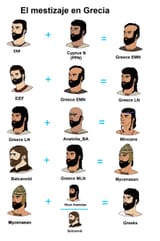Search Results
7/8/2025, 4:16:13 PM
>>17825190
>The same study also stated that at least three-quarters of the DNA of both the Mycenaeans and the Minoans came from the first Neolithic-era farmers that lived in Western Anatolia and the Aegean Sea (Mycenaeans ~74–78%, Minoans ~84–85%) while most of the remainder came from ancient populations related to the Caucasus Hunter-Gatherers and Neolithic Iran (Mycenaeans ~8–17%, Minoans ~14–15%)
>The Y-DNA haplogroup of Mycenaeans, J2a1 (in Galatas Apatheia, ca. 1700-1200), shows continuity of haplogroups from Minoan samples, so it does not clarify the potential demic diffusion of Proto-Greeks marked by R1b subclade
>A cephalometric analysis by Argyropoulos et al. (1989) published in The Angle Orthodontist showed remarkable similarity in craniofacial morphology between ancient Greeks (including Mycenaeans) and modern Greeks, suggesting a close affinity, and that the Greek ethnic group remained stable in its cephalic and facial morphology for the last 4,000 years
>A craniofacial morphological study by Papagrigorakis et al. (2014) published in Anthropologischer Anzeiger also indicated craniological similarities between modern Greeks and ancient Greeks (including Mycenaeans), indicating continuity
>In an archaeogenetic study published in Nature, Lazaridis et al. (2017) found that Minoans and Mycenaean Greeks were genetically highly similar, but not identical; modern Greeks resembled the Mycenaeans, but with some additional dilution of the early Neolithic ancestry. Furthermore, proposed migrations by Egyptian or Phoenician colonists was not discernible in their data, thus "rejecting the hypothesis that the cultures of the Aegean were seeded by migrants from the old civilizations of these regions." The FST between the sampled Bronze Age populations and present-day West Eurasians was estimated, finding that Mycenaean Greeks and Minoans were least differentiated from the populations of modern Greece, Cyprus, Albania, and Italy
>The same study also stated that at least three-quarters of the DNA of both the Mycenaeans and the Minoans came from the first Neolithic-era farmers that lived in Western Anatolia and the Aegean Sea (Mycenaeans ~74–78%, Minoans ~84–85%) while most of the remainder came from ancient populations related to the Caucasus Hunter-Gatherers and Neolithic Iran (Mycenaeans ~8–17%, Minoans ~14–15%)
>The Y-DNA haplogroup of Mycenaeans, J2a1 (in Galatas Apatheia, ca. 1700-1200), shows continuity of haplogroups from Minoan samples, so it does not clarify the potential demic diffusion of Proto-Greeks marked by R1b subclade
>A cephalometric analysis by Argyropoulos et al. (1989) published in The Angle Orthodontist showed remarkable similarity in craniofacial morphology between ancient Greeks (including Mycenaeans) and modern Greeks, suggesting a close affinity, and that the Greek ethnic group remained stable in its cephalic and facial morphology for the last 4,000 years
>A craniofacial morphological study by Papagrigorakis et al. (2014) published in Anthropologischer Anzeiger also indicated craniological similarities between modern Greeks and ancient Greeks (including Mycenaeans), indicating continuity
>In an archaeogenetic study published in Nature, Lazaridis et al. (2017) found that Minoans and Mycenaean Greeks were genetically highly similar, but not identical; modern Greeks resembled the Mycenaeans, but with some additional dilution of the early Neolithic ancestry. Furthermore, proposed migrations by Egyptian or Phoenician colonists was not discernible in their data, thus "rejecting the hypothesis that the cultures of the Aegean were seeded by migrants from the old civilizations of these regions." The FST between the sampled Bronze Age populations and present-day West Eurasians was estimated, finding that Mycenaean Greeks and Minoans were least differentiated from the populations of modern Greece, Cyprus, Albania, and Italy
6/19/2025, 10:55:55 PM
>>17776988
>Unlike the Minoans, the Mycenaeans had also "4–16% ancestry from a 'northern' ultimate source related to the hunter-gatherers of Eastern Europe and [Upper Palaeolithic] Siberia"; however, Lazaridis et al. admit that they "cannot model Mycenaeans as a mixture of Anatolian Neolithic and steppe populations [...] due to the fact that Mycenaeans have more Iran-related than EHG-related ancestry". Among the Mycenaean samples was found one Y-DNA J2a1, and two mtDNA X2, one X2d and one H
>In their archaeogenetics study, Lazaridis et al. (2017) concluded that the Minoans and the Mycenaean Greeks were genetically highly similar – but not identical – and that modern Greeks descend from these populations, ultimately proving the genetic continuity between these civilizations and modern Greeks. The same study also stated that at least three-quarters of the DNA of both the Mycenaeans and the Minoans came from the first Neolithic-era farmers that lived in Western Anatolia and the Aegean Sea (Mycenaeans ~74–78%, Minoans ~84–85%) while most of the remainder came from ancient populations related to the Caucasus Hunter-Gatherers and Neolithic Iran (Mycenaeans ~8–17%, Minoans ~14–15%)
>The Y-DNA haplogroup of Mycenaeans, J2a1 (in Galatas Apatheia, ca. 1700-1200), shows continuity of haplogroups from Minoan samples, so it does not clarify the potential demic diffusion of Proto-Greeks marked by R1b subclade
>Unlike the Minoans, the Mycenaeans had also "4–16% ancestry from a 'northern' ultimate source related to the hunter-gatherers of Eastern Europe and [Upper Palaeolithic] Siberia"; however, Lazaridis et al. admit that they "cannot model Mycenaeans as a mixture of Anatolian Neolithic and steppe populations [...] due to the fact that Mycenaeans have more Iran-related than EHG-related ancestry". Among the Mycenaean samples was found one Y-DNA J2a1, and two mtDNA X2, one X2d and one H
>In their archaeogenetics study, Lazaridis et al. (2017) concluded that the Minoans and the Mycenaean Greeks were genetically highly similar – but not identical – and that modern Greeks descend from these populations, ultimately proving the genetic continuity between these civilizations and modern Greeks. The same study also stated that at least three-quarters of the DNA of both the Mycenaeans and the Minoans came from the first Neolithic-era farmers that lived in Western Anatolia and the Aegean Sea (Mycenaeans ~74–78%, Minoans ~84–85%) while most of the remainder came from ancient populations related to the Caucasus Hunter-Gatherers and Neolithic Iran (Mycenaeans ~8–17%, Minoans ~14–15%)
>The Y-DNA haplogroup of Mycenaeans, J2a1 (in Galatas Apatheia, ca. 1700-1200), shows continuity of haplogroups from Minoan samples, so it does not clarify the potential demic diffusion of Proto-Greeks marked by R1b subclade
Page 1
